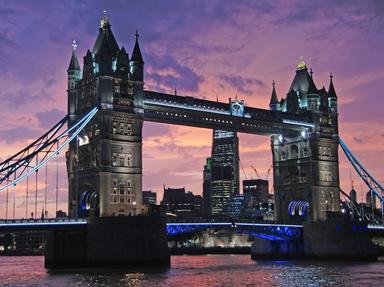Quiz Answer Key and Fun Facts
1. The Romans called the London area Londinium, where does this name stem from?
2. The Romans made two invasions of southeast England which resulted in Roman soldiers reaching the Central London area twice.
3. The London of about AD200 was surrounded by approximately how many miles of defensive walls?
4. The hospital of St Bartholomew ('Barts') was established after Henry I's court jester had a dream. True or False?
5. In what year did the Black Death, which killed approximately 30,000 of London's inhabitants, start?
6. The fate of the two young princes in the Tower of London is the subject of much speculation with the unproved assumption of Tudor historians (that Richard III murdered the children) getting the most coverage...but what were names of the young princes?
7. During the reign of Mary I, what was Smithfield notorious for?
8. What was 'To God and the Bridge'?
9. Inigo Jones, a famous Londoner, was a trend-setting gardener. True or False?
10. Where was Charles I executed?
11. Women appeared for the first time on London theatre stages in 1660?
12. What 'began at Pudding Lane and ended at Pie Corner'?
13. How many 'police' did London have in 1750?
14. The average age of mortality for the London working classes in the mid 1800s was twenty two. True or False?
15. How many Londoners did the Blitz kill?
Source: Author
Flapjack44
This quiz was reviewed by FunTrivia editor
gtho4 before going online.
Any errors found in FunTrivia content are routinely corrected through our feedback system.


